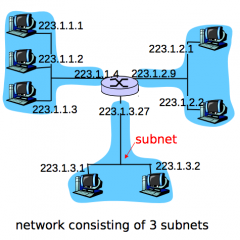![]()
![]()
![]()
Use LEFT and RIGHT arrow keys to navigate between flashcards;
Use UP and DOWN arrow keys to flip the card;
H to show hint;
A reads text to speech;
30 Cards in this Set
- Front
- Back
|
Application layer |
Hold network applications and many related protocols (HTTP for requesting and/or transferring files, SMTP for email, FTP for transferring files between two end systems, SSL, etc.) Another key application-layer protocol, DNS (Domain Name System), works to give Internet end systems more user-friendly names. |
|
|
Transport layer |
Data transfer between processes. Deliver messages from the application layer to the other endpoint(s). Uses either the TCP (connection-focused) or UDP (bandwidth-focused) protocols. |
|
|
Network layer |
Relays datagrams, or network-layer packets, between hosts. Follows the lone IP protocol to ensure that end systems and routers work to receive datagrams. However, also follows many available routing protocols to decide transport paths between sources. Provides logical communication between hosts. |
|
|
Link layer |
Helps the network layer transport a packet from one node to the next. These nodes can include hosts or routers, which are where the link layer takes over from the network layer. These different links may follow different protocols (Ethernet, Wifi, etc.) |
|
|
Physical layer |
Within the link layer, the physical layer works to deliver each bit of data across the link. Depending on the link, different protocols might come into play. |
|
|
What are the two key network-layer functions? |
* Routing: determine route taken by packets from source to destination (like planning a trip from the source to the destination) |
|
|
Some network architectures have a 3rd important function. What is it? |
* Connection setup: before datagrams flow, two end hosts AND intervening routers establish a virtual connection |
|
|
Network service model |
service model for a "channel" transporting datagrams from sender to receiver |
|
|
Example services for individual datagrams |
individual datagrams: guaranteed delivery, guaranteed delivery with less than 40 msec delay |
|
|
Describe the forwarding tables for both datagram networks and virtual-circuit networks. |
Datagram forwarding tables use a routing algorithm and the packet’s destination address to decide the output link. |
|
|
Compare and contrast link-state and distance-vector routing algorithms. |
Link-state routing uses Djikstra’s algorithm to look at all paths and calculate the least-cost paths from a source to the destination. Distance-vector routing uses dynamic programming in the form of the Bellman-Ford Equation: each node periodically sends a distance vector estimate to each of its neighbors. The equation looks at these distances to determine the least-cost path. A malfunctioning router has a different effect in both algorithms. In link-state routing, an error (particularly a node that gives an incorrect link cost) remains with the node and doesn’t propagate. With distance-vector routing, however, the incorrect information would be passed to other nodes. |
|
|
Inter-autonomous-system routing |
The (multiple) administrators want to control how exactly traffic is routed and who routes through the network. Policy can even take precedence over performance. |
|
|
Intra-autonomous-system routing |
Only one administrator, more focused on performance |
|
|
When a host joins a multicast group, must it change its IP address to that of the multicast group it is joining? |
No, the host maintains its own IP address. |
|
|
Suppose that routers were subject to conditions that might cause them to fail fairly often. Would this argue in favor of a VC or a datagram architecture? Why? |
Datagram, because it has “elastic” service and superior flexibility that would be more accommodating to router failure. Datagram architectures provide a connectionless service. |
|
|
Suppose that a source node and a destination require that a fixed amount of capacity always be available at all routers on the path between the source and destination node, for the exclusive use of traffic flowing between this source and destination node. Would this argue in favor of a VC or a datagram architecture? Why? |
VC, because it allows stricter requirements than datagram architecture. VC architectures provide a connection-focused service that allows the fixed capacity described above. |
|
|
Suppose that the links and routers in the network never fail and that routing paths used between all source/destination pairs remains constant. In this scenario, does a VC or datagram architecture have more control traffic overhead? Why? |
Datagram architecture will have more traffic overhead because packets between the same source and destination may take different paths. VC architecture will be more consistent: its connection-based architecture will produce no overhead in this kind of scenario. |
|
|
How big is the MAC address space? The IPv4 address space? The IPv6 address space? |
MAC: 6 bytes / 48 bits |
|
|
Virtual circuits |
“source-to-dest path behaves much like |
|
|
Virtual circuit implementation |
1. path from source to destination |
|
|
Datagram vs VC end systems |
VC: “dumb” end systems |
|
|
Two key router functions |
1) run routing algorithms/protocol (RIP, OSPF, BGP) |
|
|
switching rate |
rate at which packets can transfer from inputs to outputs |
|
|
Three types of switching fabrics |
Switching Via Memory - first generation routers. traditional computers with switching under |
|
|
Head-of-the-Line (HOL) blocking |
queued |
|
|
An IP address is a 32-bit identifier for... |
a host and the router interface |
|
|
Subnet |

device interfaces with same subnet part of IP address |
|
|
CIDR |
CIDR: Classless InterDomain Routing |
|
|
DHCP |
Dynamic Host Configuration Protocol |
|
|
address format: a.b.c.d/x, where x is |
# of bits in |

